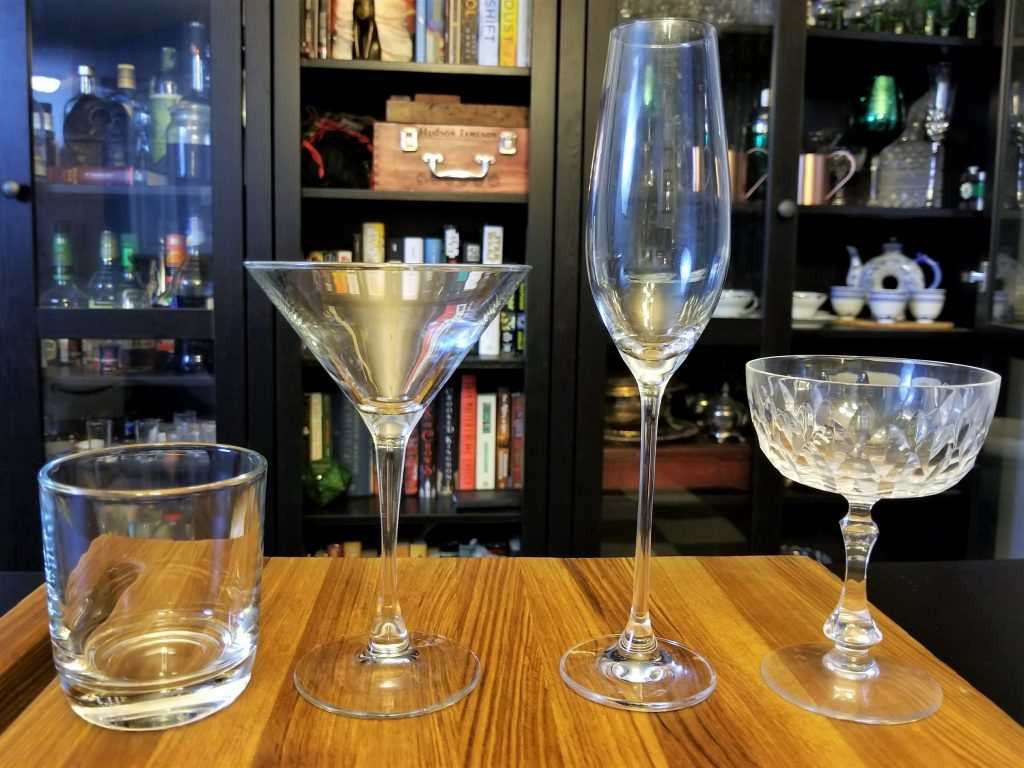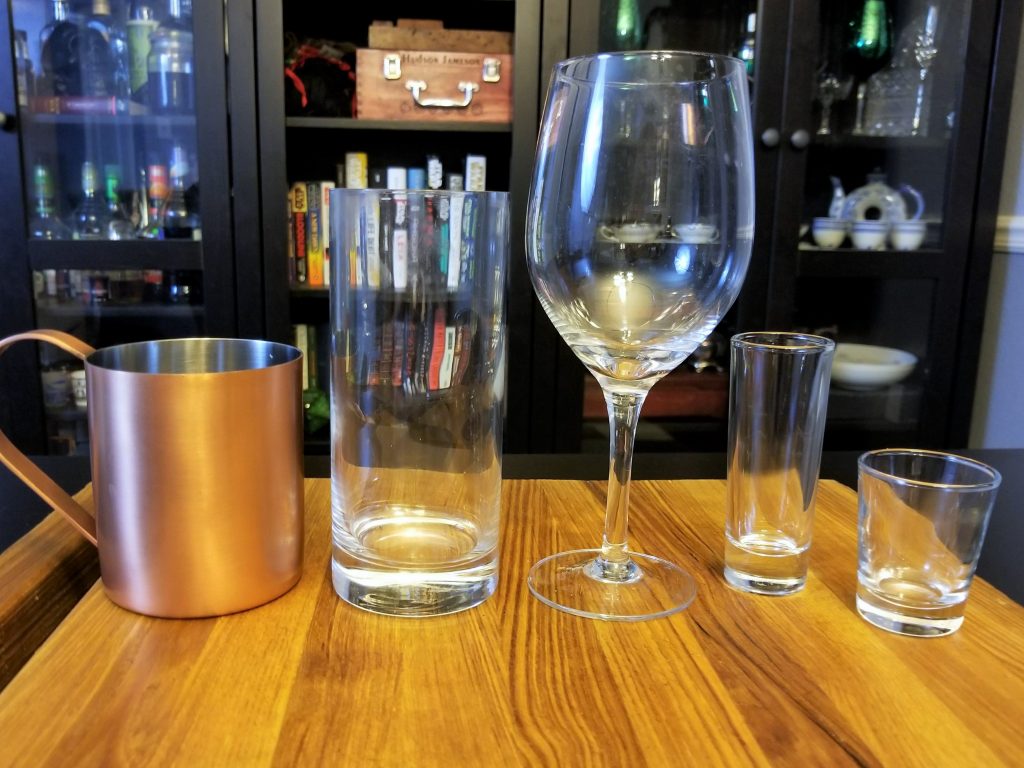Cocktail Equipment Basics
Before we get started we want to cover a few of the basics of equipment: shakers, measuring, glasses, and a few others.

Seen here: Cobbler shaker, 2 different jiggers, bar spoon
Shakers
There are a few different ways to shake up your cocktails. The two most common types of shakers are the Cobbler and the Boston Shaker.
Cobblers consist of a base tin, a straining top, and a small cap. They are easy to find and easy to use. However, the built in strainers usually have small holes that can making straining slow, especially if the drink has chunks (such as the mint in a mojito). We have cobbler shakers for their ease of use.
A Boston shaker is has only two pieces, a base tin and a glass. The glass is wedged into the tin to create a cap before shaking. These are also easy to find, and they are easier to clean than the cobbler. The cons? They can take some getting use to; making sure the two pieces are properly wedged together before shaking takes some practice. Straining anything smaller than small ice cubes will require a strainer. For the less agile out there, the glass part of the shaker is easy to break, being glass. However, it’s becoming increasingly easy to find Boston shakers where both pieces are made of metal.
Measuring
The most common measuring device for cocktails is the jigger. It consists of two metal cones attached at the points. The two sides are usually of different measurements, most often a 1 ounce and a 2 ounce. They are easy to use and easy to clean, but it can create clutter to buy multiple ones to get all the measurements you might need. This is why we recommend getting a jigger with measurement lines on the inside. OXO makes a great one with 1/4 ounce, 1/3 ounce, 1/2 ounce, 3/4 ounce, 1 ounce, and 1 1/2 ounce lines.
Regular, Imperial measuring cups and spoons can also be used. Most Americans already have them in their house, and they are quite cheap. However, they can be difficult to use for cocktails. The small amounts usually found in cocktails can be hard to measure in measuring cups, and using spoons requires calculating how many ounces they hold.
If you are using Imperial measuring cups/spoons use the following:
1 cup = 8 ounces
2 tablespoons = 1 ounce
1 tablespoon = 1/2 ounce
1 1/2 teaspoons = 1/4 ounce
Another option is the kitchen scale. While not common in America, they are easily found in places that use the metric system (so… everywhere else). If your scale does not have an Imperial option, you can easily find ounce-to-gram or ounce-to-ml conversion charts on the internet. We recommend measuring ingredients in separate containers before adding to your shaker. It’s very easy to over pour, especially with small measurements. If you accidentally add too much of an ingredient to the shaker with everything else already in it, there’s not much you can do. But if you pour too much into a small container with nothing else it’s easy to pour some of that ingredient back into its original container.
Bar Spoons
Bar spoons while not necessary, are quite useful. They have long, thin handles that make them perfect for stirring a large range of containers. You’ll notice that many bar spoons have twisted handles. This helps them glide past ice cubes.
Glasses

Seen Here: rocks glass, martini glass, champagne flute, champagne coupe
Rocks Glasses: These glasses usually hold 6 and 8 ounces of liquid, but you will usually only see them filled half way. A rocks glass is typically used for strong drinks with either a few ice cubes, an ice sphere, or no ice at all.
Common drinks: Old Fashioneds, Sazeracs, Negronis
Martini Glasses: Most martini glasses hold between 4 and 6 ounces of liquid. The stem of the glass allows you to hold the glass without heating up the drink. This is useful since the martini glass is commonly used for cold drinks that are not being served with ice.
Common drinks: Martinis, Sidecars, Manhattans
Champagne Flute: Typically 8 ounces. Much like the martini glass, the tall stem of the champagne flute prevents your hands from warming up your drink. The thin, tapered shape of the glass helps prevent too many bubbles from being created and escaping too soon.
Common Drinks: Champagne, French 75
Champagne Coupe: The coupe glass usually holds 4 to 6 ounces. Despite its name, the Champagne coupe is a sub-par glass for champagne. The wide, open shape means too many nucleation sites and therefore too many bubbles that are then lost. Much like the martini glass, they are most often used for cold drinks that are not served over ice.
Common Drinks: Clover Clubs, Pisco Sour
Martini Vs. Coupe: You might have noticed that the martini glass and the coupe glass are nearly identical. So how do you know which drinks go in each one? Short answer: you don’t. Outside of a few drinks they’re pretty interchangeable, and it comes down to personal preference. We prefer to serve drinks with froth in the coupe glass, and clear drinks in the martini glass. We just think the coupe glass lets you see the layers in a frothy drink better.

Seen Here: copper mug, highball, wine glass, shot glasses
Copper Mug: Around 16 ounces, these mugs are not solid copper. They are nickel or stainless steal with a copper coating on the outside only. The copper mug is the traditional serving vessel of the Moscow mule. Why? I don’t know. But it’s tradition! There really is no other reason than tradition and aesthetics for serving a Moscow mule in a copper mug. If you don’t have them, or don’t wish to buy them, you can use a highball.
Common Drinks: Moscow Mules
Highball: These straight up-and-down glasses are between 12 and 16 ounces. They are most commonly used for drinks served over ice, often with carbonated components.
Common Drinks: Gin Fizz, Gin and Tonic
Wine Glass: Anywhere from 10 to 25 ounces these glasses are used for, you guessed it, wine. There is a huge variation in size in wine glasses, which specific types for different varieties. Like other stemmed glasses we’ve covered, the stem prevents the wine from warming up too quickly.
Common Drinks: Wine, Wine Spritzers
Shot Glasses: Shot glasses are 1 to 3 ounces and almost exclusively used for taking shots.
Common Drinks: Shots
Others
Blenders are great for frozen, blended drinks and making fruit purees. We recommend getting the highest quality blender you can; cheap blenders will often leave large chunks of ice that stick around no matter how long you run the blender for.
Cocktail picks make small garnishes like olives and cherries easy to take out of the drink.
Tiki accouterments: tiki glasses, paper umbrellas, and colorful straws can add fun flair to tropical drinks, but are not necessary. Tiki drinks can be poured into regular highball glasses.
